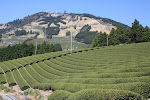 All of our teas are grown in Shizuoka-prefecture, Japan. Shizuoka is rural area located at the middle of Japan's main island, and known as home of Mt. Fuji. Also, known as production center of quality tea, Shizuoka is to tea in Japan what the Napa Valley is to wine in the United States.
All of our teas are grown in Shizuoka-prefecture, Japan. Shizuoka is rural area located at the middle of Japan's main island, and known as home of Mt. Fuji. Also, known as production center of quality tea, Shizuoka is to tea in Japan what the Napa Valley is to wine in the United States.Today, almost half of green tea
 in Japan is produced in Shizuoka. As you can see on the photo, tea farms spread as far as you can see. Not surprisingly, there are thousands of tea farmers and producers in Shizuoka.
in Japan is produced in Shizuoka. As you can see on the photo, tea farms spread as far as you can see. Not surprisingly, there are thousands of tea farmers and producers in Shizuoka.
Our tea producer (= my father = Tea Maestro) only buys teas from 11 farmers. He believes "tea quality is determined by tea farmers." Therefore, he works with these farmers and makes sure their farming processes are expert enough. Most importantly, all of his farmers have tea fields on the mountain hills. Unlike other flat tea growing areas, plants grows on steep-sided hills become strong and rich in aroma. Why? The secret is dramatic temperature fluctuation between day and night. It makes tea strong and flavorful.
If you take West-bound "Shinkansen" bullet train from Tokyo, you will pass through Shizuoka. You can see beautiful tea farms from windows.

1 comment:
I'd love to ride that bullet train out of Tokyo and visit the tea country in Japan. It seems to be true that the tea farmer makes the tea in every region it is grown unless it's blended from factory farms. But where there's any concern about quality, the farmer is of course important. And tea does usually grow well on mountainsides in many areas of the world, unless it's Assam Tea from India. --Jason
Post a Comment